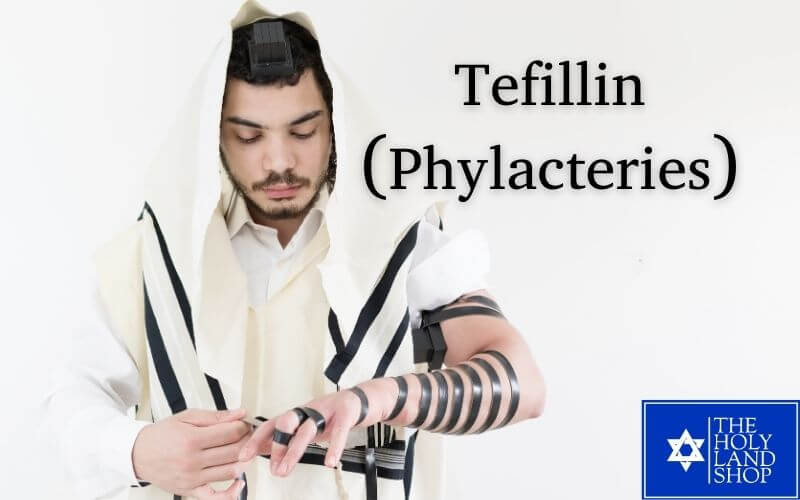Tefillin (phylacteries) are small, black boxes containing sacred texts. They are paired with leather straps. Jews wear them during weekday morning prayers. Tefillin is a powerful symbol in Judaism, holding deep spiritual significance.
Wearing phylacteries is a commandment from the Torah. This practice connects Jews to their heritage, engaging them in a timeless tradition. It is a personal devotion fostering a unique connection with God. The black boxes are placed on the arm and forehead. These positions hold special meanings. They symbolize the binding of one’s actions and thoughts to God and His teachings.
In each box, scrolls with passages from the Torah are enclosed. The words remind Jews of their obligations to God and the significance of their faith. The process of putting on Tefillin is precise and filled with meaning. Each step in the process, from placing the boxes to wrapping the straps, is deeply symbolic.
By incorporating Tefillin into daily prayers, individuals can enhance their spiritual practice. The act serves as a reminder of God’s presence, encouraging a more mindful and dedicated approach to worship. Thus, Tefillin is a vital part of Jewish religious life, enriching prayer with deeper spiritual resonance and commitment.

Historical Background of Tefillin
Phylacteries have roots in biblical times. The Torah mentions them, cementing their place in Jewish tradition. They have evolved over centuries, reflecting changes in practice and design. Initially, the concept of Tefillin was a subject of debate among scholars. Different communities adopted varied practices and designs.
Over time, standard practices emerged. Standardization in design and usage started taking shape. Throughout history, wearing Tefillin has been a way to preserve Jewish identity. They have survived periods of persecution and turmoil, maintaining their significance in Jewish life.
Various customs and styles of Tefillin have surfaced across Jewish communities. Some variations relate to the arrangement of scriptural passages. Others involve nuances in the crafting of the boxes and straps. Despite these differences, the essence of Tefillin remains constant.
Historical shifts and developments have influenced Tefillin’s design. Yet, their spiritual and symbolic value has stayed intact. This continuity showcases the enduring relevance of Tefillin in Jewish tradition. Throughout the ages, they have remained a steadfast symbol of devotion and a bridge to Jewish heritage.
The Components of Phylacteries
Phylacteries are composed of two main parts: boxes and straps. The boxes, known as batim, house sacred parchments. These parchments carry verses from the Torah. Crafted with care, the black boxes symbolize unity. They are meticulously made, ensuring they are perfectly square.
The straps, or retzuot, are also black. They secure the boxes to the arm and head. The retzuot are long, allowing for wrapping. They play a role in the ritual, enhancing the connection to God.
Inside the boxes are parchments inscribed with specific verses. These verses emphasize the oneness of God and the commandments. The writing process is intricate. A qualified scribe, or sofer, ensures precision in the inscription.
Each component of Tefillin carries deep significance. The boxes and straps are not merely physical items. They embody a profound spiritual concept, linking the wearer to divine commandments. Together, they create a powerful religious symbol essential in Jewish daily prayers.
The Art and Craftsmanship of Phylacteries
Creating phylacteries involves significant artistry and craftsmanship. Only specific materials are used, ensuring their sanctity. The leather comes from kosher animals, adding to their spiritual value. Every part, from boxes to straps, requires a careful selection of materials.
The construction process is equally meticulous. Each box is formed from a single piece of leather. It’s a detailed process, ensuring the Tefillin’s integrity. The precise work ensures that they meet religious standards.
Craftsmen also inscribe the parchments with utmost care. Special ink and quills bring the verses to life. The scribe’s skill is crucial, making each word clear and accurate.
Artistry in Tefillin goes beyond their physical appearance. The devotion and precision in their creation are forms of worship. This makes each pair unique and spiritually significant. Craftsmanship here is not just a skill but a sacred act filled with meaning and tradition.
Donning the Tefillin: A Spiritual Ritual
Donning Tefillin is a profound Jewish ritual. It’s not merely about wearing them; it’s a spiritual journey. The leather straps and boxes are placed with precision. There are specific guidelines ensuring it’s done correctly. The arm Tefillin goes on first, followed by the head. Each step is accompanied by blessings, heightening the ritual’s spirituality.
The act of wearing phylacteries is deeply symbolic. It signifies a connection between the heart and mind with the Divine. The black boxes contain scriptures, a reminder of God’s commandments. They help channel one’s focus during prayer, making the experience more intimate.
Wearing Tefillin isn’t just a physical act. It’s about embodying the scriptures and keeping them close. It enhances one’s prayers, making them resonate more powerfully. Thus, donning Tefillin is a transformative ritual, turning prayers into profound spiritual experiences.
Tefillin in Contemporary Judaism
Tefillin remains a powerful symbol in contemporary Judaism. Its presence continues, bridging traditions with the present. Modern life buzzes with change and rapid advancements. Still, the custom of donning Tefillin holds steadfast, connecting individuals to their roots.
In today’s context, wearing phylacteries is a personal choice. For many, it’s a daily reminder of their faith. It helps to anchor their spiritual identity amid the chaos of modern life. Some communities have adapted the practice, allowing for broader participation. This flexibility fosters a sense of inclusivity and adaptation to contemporary values.
Moreover, the act of wearing Tefillin has also seen diverse interpretations. People find unique personal and communal meanings in the ritual. It stands as a personal fortress, guarding tradition in the turbulence of modern times. Thus, Tefillin in contemporary Judaism flourishes as a bridge, a connector, and a holder of profound tradition and identity.
Purchasing Phylacteries
When buying Tefillin, thoughtful consideration is crucial. Firstly, ensure the phylacteries are kosher and meticulously crafted. Authenticity is vital, connecting wearers to a rich tradition. Always seek trusted and knowledgeable sellers who prioritize quality and authenticity.
Material and craftsmanship also matter. Traditionally, phylacteries are made from leather, with parchments inscribed by a skilled scribe. The boxes and straps should display impeccable workmanship. Each component, from boxes to straps, should resonate with care and precision.
Consider also the level of personal connection. The Tefillin should resonate with your spiritual journey. They should feel like a meaningful addition to your religious practice. Various styles and designs exist, each carrying unique aesthetic and spiritual appeals.
Researching and asking questions is beneficial. Knowledgeable sellers can guide your decision, ensuring a worthwhile purchase. Additionally, seeking recommendations from trusted individuals or communities can be pretty helpful. This guidance helps find phylacteries that align with your needs and spiritual aspirations.
In conclusion, buying Tefillin is a significant investment. It requires a blend of practical considerations and personal resonance. Through careful selection, one can find Tefillin that enhances their spiritual journey, embodying authenticity and personal meaning.
Conclusion
Tefillin, those special Jewish ritual items, hold a deep significance. They’re not just accessories; they’re a powerful way to deepen your connection with your faith and Jewish heritage.
So, why not consider embracing the beautiful tradition of wearing Tefillin? It’s a meaningful practice that brings you closer to your spiritual core.
We invite you to explore and purchase Tefillin to enhance your spiritual journey. These sacred items are not just a physical act but a way to enrich your Jewish identity and bond with your spirituality.
